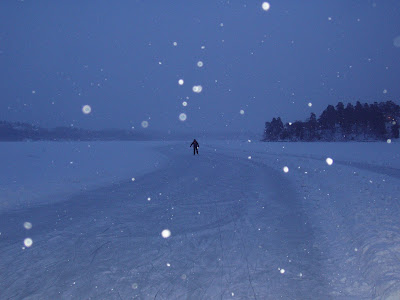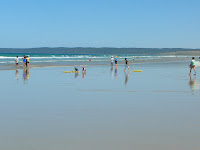Sunday, March 28, 2010
Water Bottles
It’s good to drink plenty of water. We all know this but in the drinking stakes, some of us do better than others. The hue of that stuff that tinkles into the bowl and the frequency of the said tinkling, will give you a good indication of your hydration habits and how hard your kidneys are working! Now, outputs are important and should not be overlooked, but currently, I’m interested in the input end of things…
In Sweden and in Australia we are privileged to have some of the best drinking water available at the mere turn of a tap. It’s clean, fresh and pretty much endless, despite water storage levels in Victoria being at an all time low because of our protracted drought.
With such good quality water available for free, I find myself wondering why we buy the stuff. We buy it in such prodigious quantities that bottled water sales in the USA have outstripped sales of beer. We drink it from PET bottles made from fossil fuels – mostly petroleum and natural gas. We quaff it at greatly inflated prices compared to the stuff you can get at your local kitchen sink. We recklessly quench our thirst with water that uses 2-3 times more than the amount we've imbibed just to produce it! The energy cost of manufacturing, bottling, sealing, labeling, refrigerating and transportating it, makes the environmental impact of our bottled water nothing short of horrendous.
And then there’s Bisphenol A (BPA), a key ingredient of your plastic bottle. Studies suggest a raft of possible health issues related to BPA consumption. Whilst causal links are tenuous at best, there’s enough written about BPA to throw the anxiety-switch in your brain, leaving you obsessing about worst-case health scenarios and untimely death! So with environmental destruction and life-threatening side effects, your good-ole bottled water isn’t looking so good any more.
Ok, ok, I know you’re a good citizen and you recycle. I’m sure this mediates some of the guilt you feel for your rampant aqueous consumerism. In Stockholm you’ll be traipsing down the to local recycling station with your overladen ICA or COOP bags full of glass and cardboard and plastic, to feed the big green bin-monsters in the street with their preferred substances. In Australia, you’ll be turfing your PET bottles into your own personal recycling bin in your driveway at home.
Good for you. Keep it up, but think twice.
If you have your own refillable water bottle, you will be making a difference. It’s also fun! Your local gym will undoubtedly have their own branded version as will your cycle store, your football team and your favourite holiday destination. You can choose from a range of retro and designer styles if you go for the big Swiss band. You can choose screw top or pop top…the options for creative self-expression are endless.
In Sweden the contents of our water bottles froze one day when we were skating on Edsviken. I was absolutely amazed by this incredibly cold and unAustralian phenomenon. Here in the antipodes, we have innocuous looking white water bottles that turn shocking shades of purple according to the level of UV to which they’re exposed. For those of you who know the jingle, the purpose of these chameleon bottles is to remind us to “slip on a shirt, slop on some sunscreen or slap on a hat!”
So whatever your style, impress your colleagues at work, save the planet, be kinder to your kidneys, feel quietly virtuous, save money…and make a re-usable bottle your friend today.
Note: For those of you interested in a more scholarly exposé on the energy required to produce bottled water, see the Institute of Physics.
Monday, March 15, 2010
Water
It’s 9:15pm and it’s still warm. Not hot, just pleasantly warm. The pile of paperwork clamoring for my attention on my return to Melbourne was topped by a letter requiring that we meet the specifications pertaining to the “Wildfire Management Overlay”(WMO) which covers our beachside property. This means that we must calculate a “Bushfire Attack Level” rating for our property and provide adequate information outlining building infrastructure and property management strategies to ensure that, in the case of a bushfire, we can guarantee:
- Water supply
- Appropriate access to emergency vehicles and
- An ongoing approach vegetation management that reduces risk.
It’s a far cry from the cold and wet of Stockholm, where water is everywhere and it's ok to luxuriate under the shower for more than our regulation four minutes.
My first, somewhat negative thoughts, were that this is was product of a risk averse “Bureaucratic Management Overlay”, but then the terrors of Black Saturday February 7th 2009 were triggered in my memory. Preparation and planning cannot always contain the rage of mother nature, but early warning systems and timely evacuations may have saved lives on that hot and wildly windy day last year.
We hope that we will never have cause to call on:
- “A minimum of 10,000 litres on-site static water storage maintained solely for fire fighting,”
So as I pore over my “Applicant’s Kit” I’m trying to be respectful of the origins of this legislation, philosophical about the paperwork, not cynical about other adjacent and unprepared properties that were built before the introduction of the WMO and optimistic about the building of a dream.
The optimistic bit isn’t hard. I’m imagining a barbeque on the deck whilst the cacophony of native bird-calls fades and the setting sun colours the sky a riot of beautiful fire-palette golds and reds.
But in order to realise the dream, I really need to get back to demonstrating my compliance with Permit Conditions for Option One.
Wednesday, March 10, 2010
Adult Children
March and April bring a veritable frenzy of birthdays in our family. We haven’t even recovered from Christmas and the next round of presents and celebrations are upon us. For my 1980s babies, their 2010 birthdays land them all squarely in their twenties; low, mid, high. This makes me officially old and them, inescapably adult.
But they were not always so. I was reminded of this today when I received an email from a friend. She always writes with acerbic wit and opened “God, it’s hard to be you!” and continued,“I’m stuck in suburbia with grunting adolescents and a bad haircut”.
The fact is, I have survived the grunting adolescents and bad haircuts will come and go. The odds are better for me now. I am free to come and go as I please and mercifully, grunting is no longer a preferred form of communication. Nevertheless, my adult children remain my children and still tug at the heart-strings and the purse-stings. But they’re adults. Separate. Autonomous, mostly.
I am truly grateful that they are not being sent off to fight in wars like generations of young people before them. I am perplexed by the complexity of their lives and hope they can find joy in simple pleasures. I am proud of their endurance and persistence. They are all good people. Amongst other things, I love to hear one sing, one laugh and the other to tell me about the weather.
And yes, I’ll always feel protective. I’ll worry and I’ll hope for the best for them. I can’t change the biological fact that I’m their mother and they’re my offspring and for me, a vested interest comes with the territory. But I can recalibrate my involvement and my proximity. I guess Sweden is about as far away from Australia as you can get! I love not knowing everything they’re up to. And I’m sure they love that too.
Thursday, March 4, 2010
Mesmerised
I could watch it all day.
*
Learning by Heart
Over the Christmas holiday of 2008, I read Norman Doige’s wonderful book “The Brain that Changes Itself” (2007). It was exciting, challenging and inspiring. I told all my friends to read it and my mum at 80 years of age was one of the first to do so. Another enthusiastic friend took the core message about neuroplasticity to heart in her typically creative fashion. She emailed her friends inviting us all to learn poetry and to recite to one another. I believe her personal mission has contributed to the collective forestalling of neurological decay amongst my peers! Through the sharing of stanzas and couplets, we have also shared ideas, images and experiences heart-felt.
Thus, what we now know affectionately as the Poetry Project, was born. Norman Doige MD, psychiatrist, psychotherapist and himself a poet, though I’ve only just discovered this, would be proud! After my first Shakespearean sonnet, my mother bequeathed me some of my father’s old poetry anthologies, complete with annotations in his own hand. It has been quite an emotional experience to read the words he once read and to establish a lyrical connection untrammeled by time and his untimely death.
Recitations have taken place at some wonderful dinner parties, mostly between main course and dessert. Just enough wine to soothe the nerves but not too much to interfere with rhythm and memory. Once the friend who had inaugurated the Poetry Project recited her poem with her jumper over her head! She was frozen by the presence of an audience, yet able to recall perfectly each phrase when she was ensconced in her own woollen world. On account of this peculiarity, we critically examined and debated the mechanisms of memory and recall. We have laughed a great deal and we have been clumsy, eloquent and at times, completely blank. We have been moved by Auden, Donne, Shakespeare, Wordsworth and some of our own wonderful Australian poets.
Which brings me to the reason for this blog. As mother nature assiduously touches up her white Stockholm canvas with little flurries of snow every now then, I often think of home. Our colours are so different. Stark, bright, bold. Australian Dorothea Mackellar wrote “My Country” when she was homesick in England in 1907. This well-known second stanza of her poem tells of a vastly different place…
I love a sunburnt country
A land of sweeping plains
Of ragged mountain ranges
Of droughts and flooding rains.
I love her far horizons
I love her jewel sea
Her beauty and her terror
The wide brown land for me
Dorothea Mackellar 1907


...and yes, I do know the other verses!
http://www.normandoige.com/
http://www.dorotheamackellar.com.au/
Storm photo from Reader Photo Gallery Melbourne Herald Sun 6 March 2010
Tuesday, March 2, 2010
Heat
It's hot in Australia right now. Especially on the west coast where daughter number one is living. She says the wind is like having a hairdyer blowing into your face. On the "hot" setting. It's been in the mid to high 30s for weeks and over 40 degrees some days.
The Fremantle Doctor isn't making anyone feel any better either. The Freo Doctor, or commonly just The Doctor, is the name for the ocean breeze that starts up in the afternoon bringing relief from the relentless summer heat. The Doctor blows during the summer months and usually takes a break during winter.
Heat like that saps your energy. You don't sleep as well at night and you move more slowly during the day. Grass is dry and prickly underfoot. Plants wilt. Sweat trickles. Just as Stockholmers in winter walk on the sunny side of the street, Australians are busy seeking out the shade.
So as I turn on my heater to bump up the temperature in our apartment (our windows are old and the cold leaks in at night), I'm thinking of her sleeping on the loungeroom floor because that's where the air-conditioner is.
Subscribe to:
Posts (Atom)






